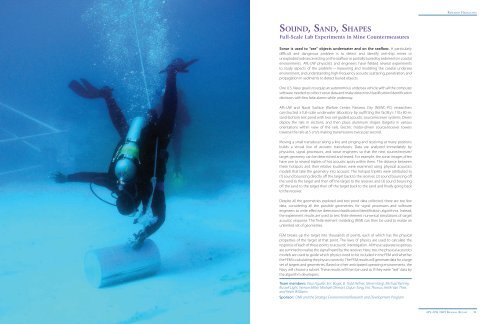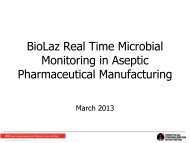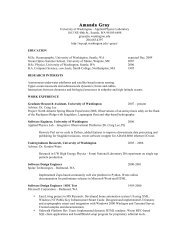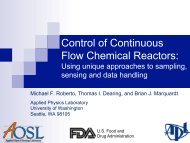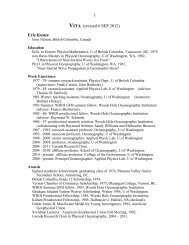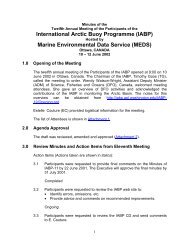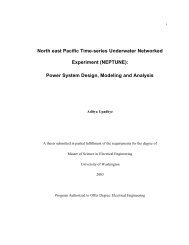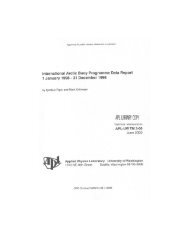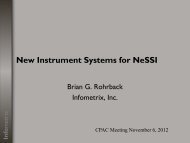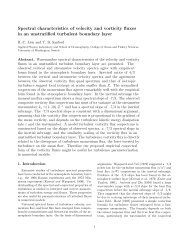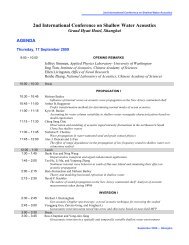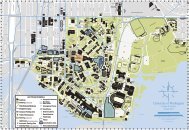2009 Biennial (PDF, 12 MB) - Applied Physics Laboratory-University ...
2009 Biennial (PDF, 12 MB) - Applied Physics Laboratory-University ...
2009 Biennial (PDF, 12 MB) - Applied Physics Laboratory-University ...
You also want an ePaper? Increase the reach of your titles
YUMPU automatically turns print PDFs into web optimized ePapers that Google loves.
Sound, Sand, SHaPeS<br />
Full-Scale Lab Experiments in Mine Countermeasures<br />
Sonar is used to “see” objects underwater and on the seafloor. A particularly<br />
difficult and dangerous problem is to detect and identify anti-ship mines or<br />
unexploded ordnance resting on the seafloor or partially buried by sediments in coastal<br />
environments. APL-UW physicists and engineers have fielded several experiments<br />
to study aspects of the problem — measuring and modeling the coastal undersea<br />
environment, and understanding high-frequency acoustic scattering, penetration, and<br />
propagation in sediments to detect buried objects.<br />
One U.S. Navy goal is to equip an autonomous undersea vehicle with all the computer<br />
software needed to collect sonar data and make detection/classification/identification<br />
decisions with few false alarms while underway.<br />
APL-UW and Naval Surface Warfare Center, Panama City (NSWC-PC) researchers<br />
constructed a full-scale underwater laboratory by outfitting the facility’s 110 x 80-m,<br />
sand-bottom test pond with two rail-guided acoustic source/receiver systems. Divers<br />
deploy the rails in sections, and then place aluminum shapes (targets) in various<br />
orientations within view of the rails. Electric motor-driven source/receiver towers<br />
traverse the rails at 5 cm/s making transmissions twice per second.<br />
Moving a small transducer along a line and pinging and receiving at many positions<br />
builds a virtual line of acoustic transducers. Data are analyzed immediately by<br />
physicists, signal processors, and sonar engineers so that the next source/receiver/<br />
target geometry can be determined and tested. For example, the sonar images often<br />
have one to several triplets of hot acoustic spots within them. The distance between<br />
these hotspots and their relative loudness were examined using physical acoustics<br />
models that take the geometry into account. The hotspot triplets were attributed to<br />
(1) sound bouncing directly off the target back to the receiver, (2) sound bouncing off<br />
the sand to the target and then off the target to the receiver, and (3) sound bouncing<br />
off the sand to the target then off the target back to the sand and finally going back<br />
to the receiver.<br />
Despite all the geometries explored and test pond data collected, there are too few<br />
data, considering all the possible geometries, for signal processors and software<br />
engineers to write effective detection/classification/identification algorithms. Instead,<br />
the experiment results are used to test finite element numerical simulations of target<br />
acoustic response. The finite element modeling (FEM) can then be used to realize an<br />
unlimited set of geometries.<br />
FEM breaks up the target into thousands of points, each of which has the physical<br />
properties of the target at that point. The laws of physics are used to calculate the<br />
response of each of these points to acoustic interrogation. All these separate responses<br />
are summed to realize the signal heard by the receiver. Here, too, the physical acoustics<br />
models are used to guide which physics need to be included in the FEM and whether<br />
the FEM is calculating the physics correctly. The FEM results will generate data for a large<br />
set of targets and geometries. Based on their anticipated operating environments, the<br />
Navy will choose a subset. These results will then be used as if they were “real” data by<br />
the algorithm developers.<br />
Team members: Paul Aguilar, Eric Boget, B. Todd Hefner, Steven Kargl, Michael Kenney,<br />
Russell Light, Vernon Miller, Michael Ohmart, Dajun Tang, Eric Thorsos, Keith Van Thiel,<br />
and Kevin Williams<br />
Sponsor: ONR and the Strategic Environmental Research and Development Program<br />
ReseARCh highLights<br />
30 APL–UW <strong>2009</strong> BienniAL RePoRt APL–UW <strong>2009</strong> BienniAL RePoRt 31


